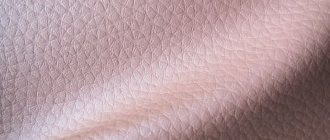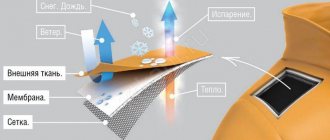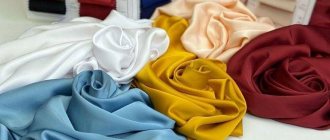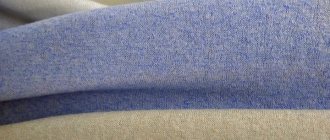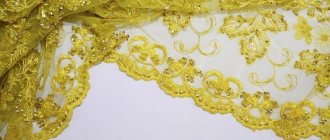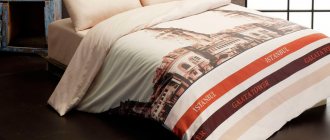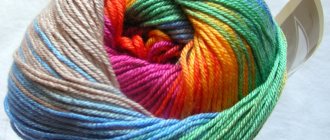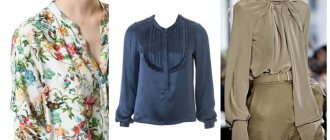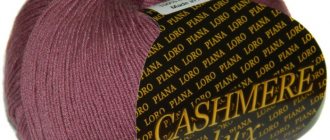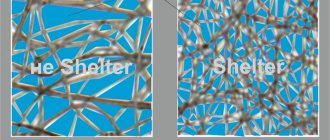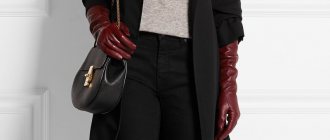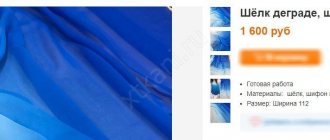What is PU leather
PU (PU, polyurethane) - all these are the names of artificial leather, which is classified as the second generation of leather substitutes. And this, of course, is not leatherette or leatherette, the properties of which we know first-hand. However, PU leather and genuine leather cannot be equated either. Although the first material is very similar to it in terms of characteristics and properties.
Before we move on to studying the features of PU leather, let’s get acquainted with the history of the appearance and development of artificial leather in our country.
A little history
Many names have been invented for substitutes for natural materials, many of which have long since taken root in our language, and we have managed to get used to them. And often, remembering that in the 90s the markets were filled with clothes made of low-quality synthetics and shoes made of low-quality leatherette, out of habit we consider everything unnatural unworthy of attention. Although the situation has long changed. And artificial is not always synonymous with low-quality.
Artificial leather has been produced on an industrial scale in the USSR since the 1930s using technology borrowed from the pulp, rubber and textile industries. The first artificial material was tarpaulin, from which boots were made for the army. The new type of leather, naturally, could not be a complete replacement for natural material, since its properties were much worse.
In search of a worthy substitute for natural leather and to preserve the lives of animals, scientists conducted new research and experiments. However, the newly obtained leatherette material was again much inferior in quality to natural leather. It was a toxic material with an unpleasant chemical smell. It did not allow air to pass through and did not absorb moisture. Nowadays this material is practically not used due to its tendency to abrasion and low wear resistance. Nevertheless, a prejudiced attitude towards artificial leather in general has been formed.
By the way, leatherette is not slang or a popular name for the material, but the real thing. It is essentially cotton fabric with a layer of nitrocellulose applied to one or both sides.
PVC leather (PVC, polyvinyl chloride) or leatherette is another type of artificial leather. It is made entirely of polymer materials. A film coating made of polyvinyl chloride with the addition of various ethereal impurities is applied to a non-woven or woven base. This makes leatherette more weather resistant. However, it accumulates moisture and does not allow air to pass through.
If a layer of PU leather is applied on top of PVC, the material becomes very similar in appearance to natural leather. Taking advantage of this, sometimes unscrupulous sellers pass it off as eco-leather.
Almost simultaneously, the Americans (in 1963) and the Japanese (in 1964) invented a material made from synthetic fiber - polyurethane. It was called eco-leather and put into production. The new type of leatherette received the prefix “eco” because polyurethane in finished products does not emit toxic substances.
The material turned out to be resistant to stretching, loads and temperature changes. Elastic, soft, without an unpleasant odor and completely unlike leatherette or leatherette. And thanks to the natural fabric base and the top layer of PU film with micropores, the artificial leather had excellent air permeability. But for all its advantages, PU leather is still an artificial product. And its composition and properties depend on the production method and technological features.
What is Eco leather
Eco-leather is a colloquial, marketing name for PU leather. After all, it is necessary to explain to the consumer that PU leather is not disgusting leatherette, in which everything sweats and stinks of chemicals, but a new modern material, no worse than natural leather.
How is PU leather different from PVC (PVC) leather
PVC (PVC, PolyVinyl Chloride) is a common plastic in its plastic form. Roughly, in general, PVC-based leatherette is a flexible plastic attached to a woven or non-woven base. This is that classic leatherette that makes your butt sweat. Hard, rough, but cheap and durable.
PVC leather is still widely used in the manufacture of various products. Often, a layer of PU leather is applied to the outer layer of PVC leather, resulting in the tactile sensation of PU leather, but cheaper.
What is leatherette
This is not a popular name, not slang, but the real name of the material. In fact, it is a fabric with a layer of nitrocellulose applied to it. Nowadays this material is practically not used due to its extremely low wear resistance. Everyone who lived in the USSR remembers the worn leatherette tables and chairs. It is because of this tendency to abrasion that they abandoned the use of leatherette.
Types of PU leather
PU artificial material is produced in two types:
- 100% polyurethane is an artificial leather made entirely from polymer materials using a chemical method.
- Fabric with a top layer of PU coating, the production of which uses pieces and trimmings of natural hides left over from the tanning industry. In processed form, natural raw materials are applied to a polymer or fabric base and coated with polymer on top for wear resistance.
In both cases, high-grade polyurethane can be used in the manufacture of leather. Both as a filler and as a covering for defective skin. It is applied to a cotton fabric base, on which a breathable microporous film is formed. The thicker the coating layer, the better the quality of the material.
At the same time, the thickness of the coating is determined by the purpose of the skin. To sew trousers and skirts, soft elastic leather with a smaller layer of top covering is required. In the production of furniture upholstery, on the contrary, a more durable and rigid material is needed.
How is polyurethane leather made?
PU fabric is a multi-layer and high-tech product. Its structure and properties resemble natural leather. The secret to obtaining a material with properties close to natural leather lies in its manufacturing technology.
The new generation material PU leather consists of several layers: base, filling and coating. The quality of PU leather directly depends on the combination and properties of the materials used in them, on the number of layers and their thickness.
The first layer (bottom) is the base. Most often, this is cotton fabric, less often - knitted or non-woven materials. The natural base, resistant to stress and stretching, makes the fabric “breathable”.
The second (middle) layer is most often a natural material treated with polymer mixtures in the form of crushed, compressed, glued together with a binder, which is applied to the first layer of the fabric base. This layer distinguishes PU leather from cheap leather substitutes.
The third layer (top) is PU coating. It consists of polyurethane applied to a base consisting of a bottom cotton layer and two or three layers of compressed defective natural material in the form of a polymer breathable film at temperatures from +130 °C to +160 °C. The name PU leather comes from the name of this polymer.
At the same stage of production, the leather is dyed, patterns and embossing are applied to it, creating a surface of different textures. In this case, the internal layers are not affected in any way. Only the top layer of the canvas, which is resistant to deformation, is processed, painted and decorated.
The three-layer “pie” technology provides the material with characteristics similar to natural leather: tensile and tensile strength, softness, frost resistance, and hygiene. In this case, no additional chemical additives are used. All the properties required for this process are already synthesized in the polymer. The polymer film does not emit anything dangerous or harmful during operation.
Material properties
Similarity to genuine leather and environmental friendliness are the main advantages of high-quality PU leather. In addition to the affordable price, eco-leather is characterized by a number of valuable properties.
- The structure of the material replicates the flexibility and plasticity of natural leather. It is lighter than artificial leather and genuine leather.
- It tolerates temperature changes well: in the cold, PU leather still remains soft and does not tan, and in the heat it does not heat up and is well ventilated through the micropores of the top layer of the film.
- Resistant to wear and mechanical stress: does not crack, tear, or stretch during wear.
- The microporous structure of the material does not prevent the skin from “breathing”. The material wicks away sweat and does not accumulate moisture. This is important in the production of shoes and clothing from PU materials.
- It does not have an unpleasant synthetic odor and does not cause irritation or allergies.
- Lightweight, elastic, soft material looks like genuine leather.
- Decorative polyurethane coating gives products fashionable shades and texture.
- PU leather is an inexpensive replacement for genuine leather products. Moreover, brands include a large number of leather products in their collections.
But just the presence of the designation “PU leather” on the label does not guarantee that all products made from it are of the same quality. To verify this, let’s compare PU leather with natural and PVC leather according to the main parameters.
Features and Specifications
Few people know what it is - PU material, although this designation has firmly penetrated the market of modern products. Many buyers confuse it with dermantine or leatherette, but this is not entirely true. Let's discuss in detail what kind of material PU leather is - it is a high-grade polyurethane polymer that imitates the structure and structure of natural material. Innovative, high-tech polyurethane has the best characteristics.
There is a full-fledged PU composition, and there is only PU upper material - what does this mean, what is the difference? It's time to talk about what the composition of PU fabric is and pay special attention to it.
- The top layer is polyurethane applied to the base;
- The basis is two or three layers of natural defective material that has been processed;
- One of the layers is genuine compressed leather;
- The base is cotton material
Only the top layer of the product is painted, decorated and processed! The inner layers are not affected during manufacturing. Useful: PVC - what kind of material this is can be read in another article.
You already know what this means – PU material. Let us note the advantages with which it is characterized:
- Resistance to low and high temperatures;
- Light weight;
- Softness;
- Air permeability;
- Environmentally friendly production;
- High elasticity;
- The material does not crack;
- Differs in vapor permeability;
- Does not accumulate moisture;
- Does not have an unpleasant odor;
- Resistant to mechanical stress.
It is important to note that the coating is not hypoallergenic, regardless of the manufacturer’s assurances. It is impossible to achieve this indicator.
We found out what this means – the main material is PU on the tag. You can buy such things without fear; they are distinguished by their quality, comfort to wear, and excellent external characteristics. You can find out what polyamide fabric means by following the link.
What is the difference between PU leather and genuine leather?
PU leather, made entirely of polyurethane, imitates the structure and structure of natural material in appearance, properties and quality. There are more similarities between them than differences. Both types of leather do not change properties in the cold, maintaining plasticity and softness at sub-zero temperatures.
In terms of breathability, eco-leather is almost equal to natural leather: it “breathes” well and absorbs moisture. In terms of texture and smell, artificial leather almost completely imitates the properties of natural material thanks to fragrances and special processing. The PU material, depending on the base, is not inferior in elasticity to its natural counterpart, which stretches well without tearing.
At the same time, PU leather is a more durable and wear-resistant material. Genuine leather becomes abraded over time. The artificial analogue is more resistant to ultraviolet radiation, chemicals, high temperatures and does not form abrasions. Another advantage of PU leather is its price. Products made from this material are several times cheaper than those made from genuine leather.
Signs by which you can distinguish genuine leather from PU leather
It is very difficult to distinguish high-quality PU leather from natural leather by external signs. It will be just as warm when you touch it and will smell just like natural. If you drop a few drops on the material, natural leather, like PU leather, will immediately absorb it and darken. But if the fabric base is visible on the cut, this is a sign that the leather is artificial. In addition, the cut edge of genuine leather is slightly thicker.
You can navigate by the label, which contains information about the lining and base of the product. But here you need to learn to understand what this or that marking on the tag means. For example, the sign “skin with a diamond” shows that the clothing is made from defective natural fabric coated with polyurethane. The diamond-shaped sign indicates an artificial analogue. The hash mark is an indicator of the textile composition.
Description
Polyurethane (PU) is a synthetic material of the elastomer group, similar to rubber. Cloths made from chemical fibers have the ability to stretch up to 200% and return to their original state without traces of deformation.
To understand what kind of material polyurethane is, you need to take a brief excursion into the technological process. The polymer, called PU, contains urethane bonds in the main chain. Their length in a macromolecule is several times greater than the transverse parameters. Thanks to this structure, connections gain flexibility and mobility in individual areas.
During the polymer synthesis process, certain parameters are set, obtaining polyurethane fibers with different properties depending on the purpose. Textile structures are obtained by secondary inhomogeneous twisting of the original raw material with synthetic or natural threads. The result is fibers to create elastic materials.
The technology includes the synthesis of a polymer in a special composition, processing of the resulting mass: the production of threads or a component for coating the base. The material's properties are similar to rubber, but it is more elastic and in many ways superior to it.
Eco-leather, a synthetic leather substitute, is made from polyurethane. The material is durable, wear-resistant, and affordable. It has many advantages, surpassing expensive natural leather in terms of performance characteristics. PU is lightweight, frost-resistant, exhibits high tensile strength and is easy to maintain.
Comparison of PU leather with PVC leather
Cheap leatherette and polyurethane leather differ greatly in properties. This is due to the technology of their production and depends on the chemical compounds used.
PVC leather is inferior to PU leather in many respects:
- plastic (polyvinyl chloride) in the base, hidden under a layer of top PU or PVC film, is toxic and can cause allergies;
- makes products hard in the cold, breaks and becomes tanned, while products made from PU leather retain their properties from -20 to +80 °C.
- leatherette - the material is inelastic and inferior in service life, over time it delaminates and cracks;
- PVC leather is cold to the touch, with a pungent chemical odor;
- PVC film does not allow air to pass through and does not absorb moisture - this is its main disadvantage and its difference from high-strength and frost-resistant polyurethane with breathability at the level of its natural counterpart;
- The only advantage of leatherette is that it is cheaper than PU leather.
How to distinguish natural material and PU leather from low-quality leatherette
The material will not heat up when you touch it with your hand. It will not absorb a drop of water applied to it due to the fact that it does not allow moisture to pass through. It will smell like synthetics and plastic. If the leather shows signs of delamination, then it is not PU leather or natural.
The secret is in the manufacturing technology
Differences in the properties of cheap leatherette and polyurethane leather are associated with production technology. Faux leather is exclusively synthetic (polyurethane or PVC). A thin layer of polymer is applied to a woven or non-woven base, on which the performance of the product depends:
- PVC imparts rigidity in the cold, peels off quite quickly due to deformation, and smells strongly of chemicals. But this is not the main disadvantage. PVC film prevents air exchange, which is essential for clothing and shoes.
- Polyurethane (PU) is an artificial material, an elastomer with high strength and frost resistance, which distinguishes it from PVC. It is difficult to remember an area where it is not used. By mixing the components in different proportions, the required degree of hardness, elasticity, flexibility or porosity is obtained. For example, durable shoe polyurethane, liquid foam in cylinders or porous polyurethane insulation are variations of the same product.
PU leather is a multi-layer product. It does contain natural raw materials, but not whole skins are used, but trimmings from the production of leather products. The mass is crushed, glued with a binder and applied to a base of cotton fibers - fabric, knitwear or non-woven fabric. Durability and similarity in characteristics to natural leather is achieved due to the top layer of colored polyurethane and characteristic embossing.
Thus, PU leather cannot be classified as natural or artificial materials. It combines both components, and its properties are almost identical to the natural product.
We offer a more clear comparison of leatherette, natural and PU leather in the table:
| Genuine Leather | PU leather | Artificial leather (leatherette, dermantin) | |
| Frost resistance | does not change properties in the cold | maintains flexibility in the range from -20°С to +120°С | tarnishes and becomes brittle |
| Air permeability | high | almost at the level of natural leather | does not allow air to pass through |
| Durability | durable, but with prolonged wear it becomes scuffed | Resistant to high temperatures, UV rays and chemicals, non-washable | cracks and delaminates over time |
| Elasticity | stretches well without tearing | depending on the base, it can be elastic and quickly returns to shape | almost no stretch |
| Texture, smell | soft, warm to the touch, with a pleasant smell | can imitate properties and smell thanks to special processing and fragrances | has a strong chemical smell and feels cold to the touch |
| Price | from 1000 rub/m2 | from 300 rub/m2 | from 150 rub/m2 |
What is recycled (pressed) leather and how is it different from natural leather?
Recycled leather - pu leather (bonded leather, reconstituted leather) - a cheaper analogue of natural leather. In its production, scraps of natural leather, leather shavings, thermoplastic resins and artificial fibers are used: polyethylene, polyesters, polyamide.
The pieces of skin remaining after cutting and processing are crushed and turned into “leather” flour. A binder material is mixed into the fibrous powder. The finished mixture of synthetic and natural fibers is melted. As a result, all components combine and, after cooling, a substance is obtained that feels and smells like leather.
In terms of properties, pressed leather cannot be equated to natural material. Since chemical components are used in its production. It is not superior in quality to artificial PU leather.
The material allows water to pass through (critical for shoes), but does not allow air to pass through. The structure of the canvas without a high-quality coating and base quickly collapses. When comparing modern PU leather and pressed leather, the advantages are on the side of the former.
By what signs can you distinguish pu leather from natural leather:
- press leather base – fabric or non-woven fiber;
- the surface of the canvas is uniform, smooth;
- there is a specific chemical smell;
- the material is cold to the touch and does not adjust to body temperature;
- When heated, it melts, releasing a pungent chemical odor.
What is special about polyurethane coated leather?
In this case, the polyurethane coating is applied not to a fabric base, as in eco-leather, but to natural animal skins with any defects or improperly processed. The polyurethane top layer solves two problems: a painted decorative PU coating with characteristic embossing corrects flaws in the natural material and at the same time preserves the properties of the natural base in the product.
What is sewn from PU fabric
An artificial material made of polyurethane with a decorative surface reminiscent of luxury expensive leather is used by designers to realize their ideas in many industries: in interior design, in the manufacture of various accessories, furniture, and clothing.
They sew from PU leather:
- shoes;
- women's and men's jackets and other outerwear;
- gloves and belts;
- purses and wallets;
- covers for phones, laptops, cameras;
- bracelets for wristwatches;
- suitcases, bags and backpacks;
- upholstery for furniture and cars;
- sporting goods: knee pads, protective masks, balls, gloves, helmets.
Types of polyurethane fabrics
Types of polyurethane fabrics
PU fabrics are divided into two groups:
- containing PU fibers;
- polyurethane coated materials.
The elastomer has found wide application in many industries. Several types of fabrics are used in the textile and haberdashery industry.
PU leather
PU leather is an environmentally friendly material used in making shoes, clothing, accessories, haberdashery, as well as for making furniture upholstery and car seat covers.
PU belongs to the class of non-woven fabrics, and is considered one of the best imitations of natural leather. Externally, the two types of material are very similar. Eco-leather is soft and pleasant to the touch. It has water-repellent properties and does not get wet. The difference with other types of leatherette is the absolute absence of a characteristic chemical odor and the ability to conduct air. In addition, PU is a durable and strong material.
Polyurethane coated fabrics
Based on polyester (polyester) and nylon coated with polyurethane on the inside, fabrics with high protection against wind and moisture are produced - Oxford. The density of matter varies from 150 to 1600 Den.
Single- and double-sided PU coating is used for the manufacture of technical textiles. A special method of applying the component to the base allows you to give the fabric the properties of a membrane: remove steam and retain water on the outer surface.
Popular types of polyurethane materials
In the textile industry and clothing production, membrane materials are especially popular (Gore-Tex, Oxford, eVent, with PU nanocoating - Polartec Neoshell, The North Face Futurelight™, Outdoor Research AscentShell); elastane fibers in the composition of the fabrics.
Depending on the country of origin, stretch elastomer fibers have different trade names:
- Japan - espa, neolan;
- USA - lycra, vairin;
- Great Britain - spanzel;
- Italy is a warrior.
Advantages and disadvantages
Reasonable price, appearance and properties of genuine leather - all this, of course, appeals to buyers in polyurethane leather. Noting the advantages of modern artificial material in reviews, many highlight such qualities as softness, lightness, elasticity of the material, and comfort for the body. The price is quite satisfactory, which means you can please yourself with new things and update the interior more often.
Among the reviews there are also negative ones. For example, it is very difficult to get rid of pet scratches if they appear on polyurethane products. Furniture upholstery made from this material is also easy to ruin if there are small children in the house who like to paint wallpaper, tables and furniture with paints and felt-tip pens.
If clothes are made from cheap leather, they are not very comfortable in cold weather.
What is PU and TPU outsole?
TPU OUTSOLE - SINGLE LAYER
Thermoplastic polyurethane is resistant to abrasion, low temperatures, tearing and aggressive environments, adheres well to the surface, restores its shape when deformed, is able to perfectly resist punctures, has slip resistance, and it is possible to manufacture soles with large lugs . The disadvantages of TPU include the high density of the material, which, in turn, affects the weight and elasticity of the finished product. The sole of this material adheres relatively poorly to the top of the workpiece using the injection molding method of fastening. The material, as the name suggests, is not resistant to high temperatures (+80 C) - then the sole will simply melt, which makes it unsuitable for the manufacture of safety shoes, the operation of which is implied in conditions of aggressive temperatures: hot workshops, hot asphalt, etc. The strength of attachment to the top of the shoe is low. Equipment for the production of TPU soles is quite expensive. It is rarely used in safety shoes, since the above-mentioned disadvantages (weight, thermoplasticity, rigidity, shock-absorbing properties, high price) prevail over the positive characteristics.
TPU/PU OUTSOLE – DOUBLE LAYER
Thermopolyurethane is often combined with polyurethane - where the running layer is made of thermopolyurethane, and the intermediate shock-absorbing layer is made of low-density polyurethane. It is possible to manufacture shoes with deep tread and large lugs from TPU Safety shoes with TPU/PU soles also resist slipping like TPU and are better than products made from single-layer polyurethane and, especially, double-layer ones; has less weight than single-layer TPU , but is heavier than shoes with PU soles, but at the same time, the strength characteristics are excellent. This sole will not break or burst in the cold. The polyurethane layer provides good thermal insulation for safety shoes and adheres well to the top of the safety footwear blank. TPU is a thermoplastic material, so it wears out quickly in summer and can melt on hot surfaces, which makes it impossible to wear such shoes , for example, in hot workshops. But for winter and the off-season it is one of the best options. Lightweight, durable, maybe with large and deep lugs, slips less, but its cost is quite high.
Thermopolyurethane is used in the production of all-season attractions and can withstand maximum loads in both temperature conditions. Among themselves, experts from the “inflatable business” call it “all-season material.” The increased strength is explained by the complex chemical composition, so for manufacturing it is necessary to spend a sufficient number of expensive components, which as a result results in the expensive cost of the structure itself. The high price speaks not only of its reliability all year round , it is also an indicator of maximum ductility and resistance to wear of the surface itself from abrasion. For some, this aspect is a priority: many strive to ensure that the attraction, even after several years, does not change its original appearance.
How to care for eco leather
Products made from high-quality eco-leather can replace shoes and jackets made from natural materials. However, you need to care for them as carefully as for products made from genuine leather.
To remove minor stains, simply wipe the stain with a soft, damp cloth, then dry.
It is recommended to clean stains of organic origin with products intended for natural leather, following the instructions.
To improve the water-repellent properties of the product and extend its service life, it is recommended to treat the leather with special impregnations for natural clothing and shoes.
Answering the question: is PU leather synthetic or a natural product? We can say that it is an artificial material. Despite the partial content of processed natural leather, its production still uses high-tech chemical processes.
Is polyurethane harmful to humans?
Polyurethane is an environmentally friendly type of synthetic raw material that is harmless to human health. In the process of its production, formaldehyde, freon, asbestos and other chemical components that can release highly volatile ether fractions are not used.
It is worth considering that the material does not provide optimal air exchange and vapor conductivity. Therefore, the use of PU in clothing and footwear has some limitations. In particular, clothing made from this textile is not suitable for long-term wear during the day.
